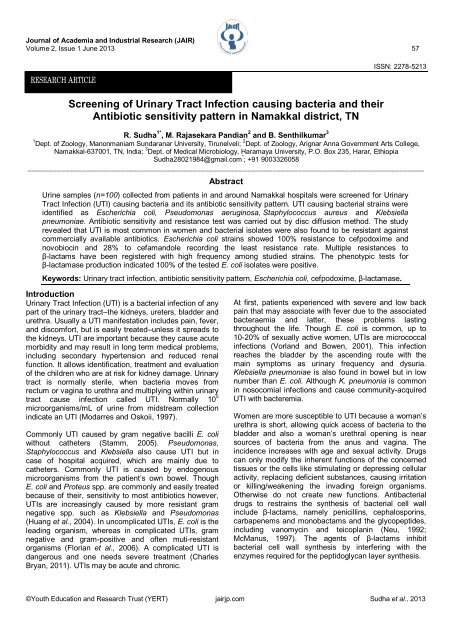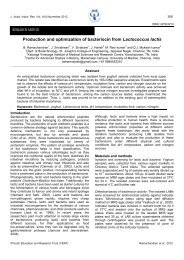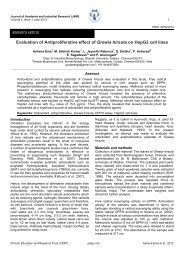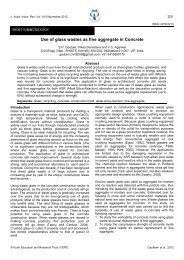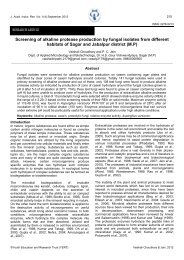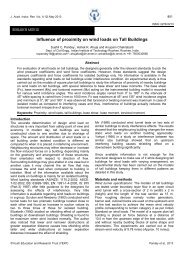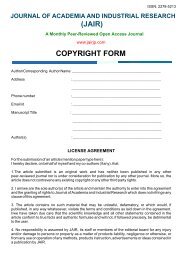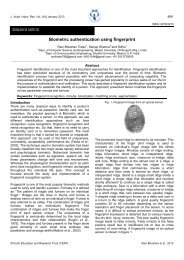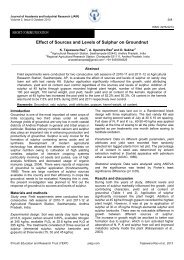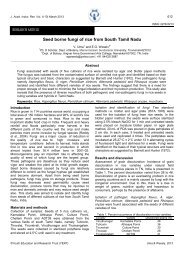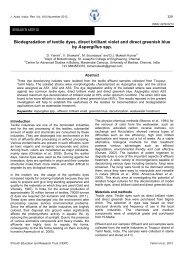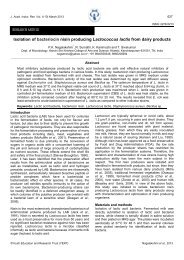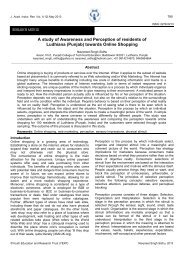Screening of Urinary Tract Infection causing bacteria and their ...
Screening of Urinary Tract Infection causing bacteria and their ...
Screening of Urinary Tract Infection causing bacteria and their ...
Create successful ePaper yourself
Turn your PDF publications into a flip-book with our unique Google optimized e-Paper software.
Journal <strong>of</strong> Academia <strong>and</strong> Industrial Research (JAIR)Volume 2, Issue 1 June 2013 57RESEARCH ARTICLEISSN: 2278-5213<strong>Screening</strong> <strong>of</strong> <strong>Urinary</strong> <strong>Tract</strong> <strong>Infection</strong> <strong>causing</strong> <strong>bacteria</strong> <strong>and</strong> <strong>their</strong>Antibiotic sensitivity pattern in Namakkal district, TNR. Sudha 1* , M. Rajasekara P<strong>and</strong>ian 2 <strong>and</strong> B. Senthilkumar 31 Dept. <strong>of</strong> Zoology, Manonmaniam Sundaranar University, Tirunelveli; 2 Dept. <strong>of</strong> Zoology, Arignar Anna Government Arts College,Namakkal-637001, TN, India; 3 Dept. <strong>of</strong> Medical Microbiology, Haramaya University, P.O. Box 235, Harar, EthiopiaSudha28021984@gmail.com * ; +91 9003326058______________________________________________________________________________________________AbstractUrine samples (n=100) collected from patients in <strong>and</strong> around Namakkal hospitals were screened for <strong>Urinary</strong><strong>Tract</strong> <strong>Infection</strong> (UTI) <strong>causing</strong> <strong>bacteria</strong> <strong>and</strong> its antibiotic sensitivity pattern. UTI <strong>causing</strong> <strong>bacteria</strong>l strains wereidentified as Escherichia coli, Pseudomonas aeruginosa, Staphylococcus aureus <strong>and</strong> Klebsiellapneumoniae. Antibiotic sensitivity <strong>and</strong> resistance test was carried out by disc diffusion method. The studyrevealed that UTI is most common in women <strong>and</strong> <strong>bacteria</strong>l isolates were also found to be resistant againstcommercially available antibiotics. Escherichia coli strains showed 100% resistance to cefpodoxime <strong>and</strong>novobiocin <strong>and</strong> 28% to cefam<strong>and</strong>ole recording the least resistance rate. Multiple resistances toβ-lactams have been registered with high frequency among studied strains. The phenotypic tests forβ-lactamase production indicated 100% <strong>of</strong> the tested E. coli isolates were positive.Keywords: <strong>Urinary</strong> tract infection, antibiotic sensitivity pattern, Escherichia coli, cefpodoxime, β-lactamase.Introduction<strong>Urinary</strong> <strong>Tract</strong> <strong>Infection</strong> (UTI) is a <strong>bacteria</strong>l infection <strong>of</strong> anypart <strong>of</strong> the urinary tract–the kidneys, ureters, bladder <strong>and</strong>urethra. Usually a UTI manifestation includes pain, fever,<strong>and</strong> discomfort, but is easily treated–unless it spreads tothe kidneys. UTI are important because they cause acutemorbidity <strong>and</strong> may result in long term medical problems,including secondary hypertension <strong>and</strong> reduced renalfunction. It allows identification, treatment <strong>and</strong> evaluation<strong>of</strong> the children who are at risk for kidney damage. <strong>Urinary</strong>tract is normally sterile, when <strong>bacteria</strong> moves fromrectum or vagina to urethra <strong>and</strong> multiplying within urinarytract cause infection called UTI. Normally 10 5microorganisms/mL <strong>of</strong> urine from midstream collectionindicate an UTI (Modarres <strong>and</strong> Oskoii, 1997).Commonly UTI caused by gram negative bacilli E. coliwithout catheters (Stamm, 2005). Pseudomonas,Staphylococcus <strong>and</strong> Klebsiella also cause UTI but incase <strong>of</strong> hospital acquired, which are mainly due tocatheters. Commonly UTI is caused by endogenousmicroorganisms from the patient’s own bowel. ThoughE. coli <strong>and</strong> Proteus spp. are commonly <strong>and</strong> easily treatedbecause <strong>of</strong> <strong>their</strong>, sensitivity to most antibiotics however,UTIs are increasingly caused by more resistant gramnegative spp. such as Klebsiella <strong>and</strong> Pseudomonas(Huang et al., 2004). In uncomplicated UTIs, E. coli is theleading organism, whereas in complicated UTIs, gramnegative <strong>and</strong> gram-positive <strong>and</strong> <strong>of</strong>ten muti-resistantorganisms (Florian et al., 2006). A complicated UTI isdangerous <strong>and</strong> one needs severe treatment (CharlesBryan, 2011). UTIs may be acute <strong>and</strong> chronic.At first, patients experienced with severe <strong>and</strong> low backpain that may associate with fever due to the associatedbacteraemia <strong>and</strong> latter, these problems lastingthroughout the life. Though E. coli is common, up to10-20% <strong>of</strong> sexually active women, UTIs are micrococcalinfections (Vorl<strong>and</strong> <strong>and</strong> Bowen, 2001). This infectionreaches the bladder by the ascending route with themain symptoms as urinary frequency <strong>and</strong> dysuria.Klebsiella pneumoniae is also found in bowel but in lownumber than E. coli. Although K. pneumonia is commonin nosocomial infections <strong>and</strong> cause community-acquiredUTI with bacteremia.Women are more susceptible to UTI because a woman’surethra is short, allowing quick access <strong>of</strong> <strong>bacteria</strong> to thebladder <strong>and</strong> also a woman’s urethral opening is nearsources <strong>of</strong> <strong>bacteria</strong> from the anus <strong>and</strong> vagina. Theincidence increases with age <strong>and</strong> sexual activity. Drugscan only modify the inherent functions <strong>of</strong> the concernedtissues or the cells like stimulating or depressing cellularactivity, replacing deficient substances, <strong>causing</strong> irritationor killing/weakening the invading foreign organisms.Otherwise do not create new functions. Anti<strong>bacteria</strong>ldrugs to restrains the synthesis <strong>of</strong> <strong>bacteria</strong>l cell wallinclude β-lactams, namely penicillins, cephalosporins,carbapenems <strong>and</strong> monobactams <strong>and</strong> the glycopeptides,including vanomycin <strong>and</strong> teicoplanin (Neu, 1992;McManus, 1997). The agents <strong>of</strong> β-lactams inhibit<strong>bacteria</strong>l cell wall synthesis by interfering with theenzymes required for the peptidoglycan layer synthesis.©Youth Education <strong>and</strong> Research Trust (YERT) jairjp.com Sudha et al., 2013
Journal <strong>of</strong> Academia <strong>and</strong> Industrial Research (JAIR)Volume 2, Issue 1 June 2013 58Table 1. Preliminary tests <strong>and</strong> biochemical characterization <strong>of</strong> <strong>bacteria</strong>l isolates.S. aureusPositivecocciNon-motilePositiveNegativeA+A+A+A+A+NegativePositiveNegativeNegativePositivePositive-K. pneumoniaeNegativeNon-motilePositiveNegativeA+G+A+G+A+G+A+G+A+G+NegativeNegativePositivePositivePositivePositiveA/A,G+P. aeruginosaNegativerodMotilePositivePositiveA+NegativeNegativeNegativeA+G+NegativeNegativeNegativePositiveNegativePositiveAk/AE. coliNegativeshort rodMotilePositiveNegativeA+G+NegativeA+G+NegativeNegativePositivePositiveNegativeNegativeNegativePositiveA/A, G+IsolatesGramstainingMotilityCatalaseOxidaseGlucoseSucroseLactoseMannitolMaltoseIndoleMRVPCitrateUreaseNitrateTSIMR-Methyl red; VP-Vogues Proskauer; TSI – Triple sugar iron; A+- Acid production; G+ Gas production; Ak- Alkaline.Extended-spectrum β-lactamase (ESBL) producingE. coli are increasingly by acquisition <strong>of</strong> resistancecharacter from resistance organism to susceptible onethrough genetic transformation. Because <strong>of</strong> the extensiveuse <strong>of</strong> antimicrobial substances the outcome out <strong>of</strong>multi-resistance strains <strong>and</strong> urinary tract infections areincreasing day-by-day. Based on particularcharacteristics <strong>of</strong> the patients, UTIs are common inneurological pathology (Banciu, 2005). According toKeen (2012) in <strong>bacteria</strong>, virulence factors are <strong>of</strong>tenencoded on mobile genetic elements, such asbacteriophages <strong>and</strong> can easily spread through horizontalgene transfer. Against these backdrops, it was aimed toscreen UTI <strong>causing</strong> <strong>bacteria</strong> <strong>and</strong> its antibiotic sensitivitypattern <strong>and</strong> virulence factors among patients in <strong>and</strong>around Namakkal hospitals.Materials <strong>and</strong> methodsSample collection: A total <strong>of</strong> 100 urine samples werecollected in each 30 mL sterile plastic bottle from thepatients located in <strong>and</strong> around Namakkal hospitals.The samples were properly labeled indicating the source,date, time <strong>of</strong> collection, sex <strong>and</strong> age <strong>of</strong> patients.The urine samples were transported in cooler boxes toLaboratory for bacteriological investigations within 4-6 h<strong>of</strong> collection.Isolation <strong>of</strong> <strong>bacteria</strong>: Culture plates <strong>of</strong> Nutrient Agar (NA)were used for the isolation <strong>of</strong> <strong>bacteria</strong>l strains from urinesamples. The collected urine samples were streakeddirectly on the labeled agar plates <strong>and</strong> incubated at 37Cfor 24 h. After incubation, cultures were examined forsignificant growth. Subcultures were then made intoplates <strong>of</strong> NA <strong>and</strong> incubated for another 24 h. Cultureplates <strong>of</strong> NA, Eosin Methylene Blue Agar, MacConkeyAgar <strong>and</strong> Mannitol Salt Agar (Hi media, Bombay, India)were used.Identification <strong>of</strong> <strong>bacteria</strong>: The primary identification <strong>of</strong> the<strong>bacteria</strong>l isolates was made based on colonialappearance <strong>and</strong> pigmentation. St<strong>and</strong>ard biochemicaltests were performed to identify the <strong>bacteria</strong>l strains.Characterization <strong>and</strong> identification <strong>of</strong> the isolates wasdone using the methods <strong>of</strong> Cowan <strong>and</strong> Steel (1985),Fawole <strong>and</strong> Oso (1988) <strong>and</strong> Cheesbrough (2004).Antibiotic susceptibility test: All isolates were subjectedinto antibiotic susceptibility test according to Nair et al.(2005). The susceptibility <strong>of</strong> isolates <strong>of</strong> E. coli toantimicrobial agents was examined by agar disc diffusionmethod. The zone <strong>of</strong> inhibition <strong>and</strong> resistance wasmeasured, recorded <strong>and</strong> interpreted according to therecommendation <strong>of</strong> the disc manufacture.©Youth Education <strong>and</strong> Research Trust (YERT) jairjp.com Sudha et al., 2013
Journal <strong>of</strong> Academia <strong>and</strong> Industrial Research (JAIR)Volume 2, Issue 1 June 2013 60Table 4. Antibiotic resistance <strong>of</strong> E. coli isolates.Strain GE CF A E Co NA T CZX CPD CE K B Va Nv Ak Am NF TM Nr Cef%ResistanceE-1 R R R R R R R R R R I I I R R R I S S S 65E-14 R R R R R R R R R I I I R R R R R S S S 70E-16 R R R R I R R R R R R I R R R R R S R R 85E-17 R R R R R R R R R R R R R R R R R S S S 85E-18 R R R R I R R R R R R I R R R R R S R R 85E-21 R I R R I R I R R R R R R R R R R S S S 70E-27 I R R R I I R I R I R R R R R R I S S S 55E-30 R R R R R R R R R I I I R R R R R S S S 70E-40 R R R I I I R R R R R R R R S R R S S S 65E-41 R R I I I R R R R R R R R R S R R R S R 75E-42 R I R R I R I R R R R R R R R R R S S S 70E-48 S I R R R I R R R I R R R R S R R R R R 75E-58 S I R I I I R R R R R R R R R R R R S R 70E-59 R I R R I R I R R R R R R R R R R S S S 70E-60 I S S R S I I R R I R R R R S R I R S S 45E-61 I S I R R R R R R I R R R R S S R R S S 60E-65 S I R R R S R R R R I R R R R S S S S R 60E-72 S R R R I S R I R R R R R R R S R S S R 65E-80 S R R R R I R R R R R R R R S R R R R S 80E-85 R I R R R S R R R R R R R R R R R S R S 80E-86 I I R I R S R I R R I R R R S S R R R S 55E-87 R R R R R R R R R R R R R R R S R R R S 90E-97 S I I I I R R R R I I R R R I S R R R S 50E-98 R I R R I R I R R R R R R R R R R S S S 70E-99 S I R R S S R R R I R R R R R S I R R S 60R = Resistance; S = Sensitive; I = Intermediate.In the present study, the most resistance rates <strong>of</strong> E. colidetected from urine culture were found to 100%resistance to Cefpodoxime (CPD) <strong>and</strong> Novobiocin (Nv)<strong>and</strong> 28% to Cefam<strong>and</strong>ole. Kenneth Todar (2012)reported strains that are resistant to all available clinicallyuseful antibiotics except vancomycin. Present studyshowed 100% <strong>of</strong> the isolates were beta lactamaseproducers (Table 5). In case <strong>of</strong> cell surfacehydrophobicity analysis, the highest percentage wasobtained in female (88.54%) in 37 years <strong>of</strong> age <strong>and</strong>lowest (75.23%) in 27 years <strong>of</strong> age. In male, highestpercentage (86.95%) was observed in 53 years <strong>of</strong> age<strong>and</strong> lowest (75.29%) in 35 years.Highest incidences (positive) for slime production wererecorded in female (60.87%) followed by male (39.13%).In female, out <strong>of</strong> 6 types <strong>of</strong> age groups, the highestprevalence was recorded in the age group between21-30 years (28.57%) <strong>and</strong> lowest in the age groupbetween 41-50 years (7.14%) <strong>and</strong> in male, highestprevalence was recorded in age groups <strong>of</strong> 11-20, 21-30,31-40 <strong>and</strong> above 50 (22.22%) <strong>and</strong> lowest in 41-50 years(11.11%) <strong>and</strong> no production in 0-10 years (Table 6).β-lactamase production indicated 100% <strong>of</strong> the testedE. coli isolates are positive <strong>and</strong> cell surfacehydrophobicity test revealed 75-88% <strong>of</strong> cells in surface <strong>of</strong>xylene.©Youth Education <strong>and</strong> Research Trust (YERT) jairjp.com Sudha et al., 2013
Journal <strong>of</strong> Academia <strong>and</strong> Industrial Research (JAIR)Volume 2, Issue 1 June 2013 61Table 5. Virulence factors <strong>of</strong> E.coli isolates.Strain SexAgeCell surfaceβ –lactamase(years)hydrophobicityE-1 F 10 Positive 83.49E-14 F 27 Positive 75.23E-16 F 21 Positive 80.76E-17 F 15 Positive 77.31E-18 M 45 Positive 86.40E-21 M 22 Positive 82.65E-27 F 31 Positive 87.5E-30 F 22 Positive 81.18E-40 M 35 Positive 75.29E-41 F 34 Positive 79.31E-42 M 17 Positive 81.05E-48 M 59 Positive 85.71E-58 F 30 Positive 86.66E-59 F 27 Positive 81.48E-60 M 19 Positive 84.14E-61 M 37 Positive 85.56E-65 F 10 Positive 88.42E-72 M 53 Positive 86.95E-80 F 20 Positive 84.21E-85 M 25 Positive 82.29E-86 M 31 Positive 82.72E-87 F 66 Positive 76.85E-97 F 49 Positive 81.65E-98 F 52 Positive 80.35E-99 F 37 Positive 88.54Thus, the highest incidence <strong>of</strong> virulence factors, recordedby the E. coli strains became more resistance to severalantibiotics because they help the organism to overcomehost defenses <strong>and</strong> colonize or invade the urinary tract.Virulence factors are very <strong>of</strong>ten responsible for <strong>causing</strong>disease in the host because they are <strong>of</strong>ten responsiblefor converting non-pathogenic <strong>bacteria</strong> into dangerouspathogens.ConclusionPrevalence rate <strong>of</strong> E. coli was found to be the mostcommonest organism for UTI in all age groups <strong>and</strong>showed resistance to commonly used antibioticsespecially, 100% resistant to cefpodoxime <strong>and</strong>novobiocin. The test isolates <strong>of</strong> E. coli tested positive inβ-lactamase, slime production <strong>and</strong> higher percentage incell surface hydrophobicity showed high antibioticresistance. But the prevalence <strong>of</strong> antimicrobial resistancecan vary according to geographical <strong>and</strong> regional location.Hence, finally we recommend the selection <strong>of</strong> antibioticshould be based on knowledge <strong>of</strong> local prevalence <strong>and</strong>we suggest to mitigate the problem <strong>of</strong> antibioticresistance is development <strong>of</strong> new antimicrobial drugs forUTIs.References1. Alon, U., Davidai, G., Berant, M. <strong>and</strong> Merzbach, D. 1987.Five-years survey <strong>of</strong> changing patterns <strong>of</strong> susceptibility <strong>of</strong><strong>bacteria</strong>l uropathogens to trimethoprim sulfamethoxazole<strong>and</strong> other antimicrobial agents. Antimicrob. AgentsChemother. 31: 126-128.2. Banciu, N. 2005. Preventia infectiei si higiena in mediulspitalicesc. Editura Viata Medicala Romaneasca, Bucuresti.3. Barret, S.P., Savage, M.A., Rebec, M.P., Guyot, A.,Andrews, N. <strong>and</strong> Shrimpton, S.B. 1999. Antibiotic sensitivity<strong>of</strong> <strong>bacteria</strong> associated with community-acquired urinarytract infection in Britain. J. Antimicrob. Chemother. 44: 359-365.4. Charles Bryan. 2011. Infectious disease, chapter seven,<strong>Urinary</strong> tract infections from Infectious Disease Section <strong>of</strong>Microbiology <strong>and</strong> Immunology On-line. University <strong>of</strong> SouthCarolina.5. Cheesbrough, M. 2004. Morphology <strong>and</strong> characterization <strong>of</strong>E. coli <strong>and</strong> S. aureus. District laboratory practice in tropicalcountries part II. Cambridge University. pp.157-179.6. Cowan, S.T. <strong>and</strong> Steel, K.J. 1985. Manual for theidentification <strong>of</strong> medical <strong>bacteria</strong>. 4 th edn. CambridgeUniversity Press. London. p.217.7. Czaja, C.A. <strong>and</strong> Hooton, T.M. 2006. Update acuteuncomplicated urinary tract infection in women. Postgrad.Med. 119: 39-45.8. Fawole, M.O. <strong>and</strong> Oso, B.A. 1988. Laboratory manual formicrobiology, 1 st edn. Spectrum Book Ltd., Ibadan. pp.22-45.9. Florian, M.E., Wagenlehner, K.G. <strong>and</strong> Naber, S. 2006.Treatment <strong>of</strong> <strong>bacteria</strong>l urinary tract infections: Presence <strong>and</strong>future. Euro. Assoc. Urol. 49: 235-244.10. Foxman, B., Barlow, R., D’Arcy, H., Gillespie, B. <strong>and</strong> Sobel,J.D. 2000. Self reported incidence <strong>of</strong> urinary tract infection<strong>and</strong> associated costs. Ann. Epidemiol. 10: 509-15.11. Freeman, D.J., Falkiner, F.R. <strong>and</strong> Keane, C.T. 1989. Newmethod for detecting slime production by coagulasenegative Staphylococci. J. Clin. Pathol. 42: 872-874.12. Gruneberg, R.N. 1994. Changes in urinary pathogens <strong>and</strong><strong>their</strong> antibiotic sensitivities, 1971-1992. J. Antimicrob.Chemother. 33(A): 1-8.13. Gupta, K., Scholes, D. <strong>and</strong> Stamm, W.E. 1999. Increasingprevalence <strong>of</strong> antimicrobial resistance among uropathogens<strong>causing</strong> acute uncomplicated cystitis in women. JAMA. 281:736-738.SexMaleFemaleSlimeproducersTable 6. Slime activity <strong>of</strong> E. coli isolates according to sex <strong>and</strong> age groups.Age group (years)0-10 11-20 21-30 31-40 41-50 Above 50Negative - - - 1 - -Weak - - - 1 - -Moderate - 1 2 1 - 2Strong - 1 - - 1 -Negative - - 1 - - -Weak 1 1 - - - -Moderate 1 1 - 3 1 -Strong - - 4 - - 2TotalNo. <strong>of</strong>positives914% <strong>of</strong>occurrence92©Youth Education <strong>and</strong> Research Trust (YERT) jairjp.com Sudha et al., 2013
Journal <strong>of</strong> Academia <strong>and</strong> Industrial Research (JAIR)Volume 2, Issue 1 June 2013 6214. Hooton, T.M. <strong>and</strong> Stamm, W.E. 1997. Diagnosis <strong>and</strong>treatment <strong>of</strong> uncomplicated urinary tract infection. Infect.Dis. Clin. North Am. 11: 551-581.15. Huang, W.C., Wann, S.R. <strong>and</strong> Lin, S.L. 2004. Catheterassociated urinary tract infections in intensive care unitscan be reduced by prompting physicians to removeunnecessary catheters. Infect. Control Hosp. Epidemiol. 25:974-978.16. Kasper, D.L., Fauci, A.S. <strong>and</strong> Longo, D.L. 2005. Harrison’sPrinciple <strong>of</strong> International Medicine. 16 th edn. New York, NY:McGraw Hill.17. Keen, E.C. 2012. Paradigms <strong>of</strong> pathogenesis: Targeting themobile genetic elements <strong>of</strong> disease. Frontiers Cell. Infect.Microbiol. 2: 161.18. Kenneth Todar. 2012. Todar’s online textbook <strong>of</strong>bacteriology: Bacterial resistance to antibiotics, University <strong>of</strong>Wisconsin.19. Kunin, C.M. 1997. <strong>Urinary</strong> tract infections: detection,prevention, <strong>and</strong> management, 5 th edn. Williams & Wilkins,Baltimore, Md.20. Lateef, A., Oloke, J.K. <strong>and</strong> Gueguim-kana, E.B. 2004.Antimicrobial resistance <strong>of</strong> <strong>bacteria</strong>l strains isolated fromorange juice products. Afr. J. Biotechnol. 3(6): 334-338.21. Lautenbach, E., Strom, B.L. <strong>and</strong> Bilker, W.B. 2001.Epidemiological investigation <strong>of</strong> fluoroquinolone resistancein infections due to extended-spectrum beta-lactamaseproducingEscherichia coli <strong>and</strong> Klebsiella pneumoniae. Clin.Infect. Dis. 33: 1288-1294.22. Maartens, G. <strong>and</strong> Oliver, S.P. 1994. Antibiotic resistance incommunity-acquired urinary tract infection. S. Afr. Med. J.84: 600-602.23. MacGowan, A.P., Brown, N.M., Holt, H.A., Lovering, A.M.,McCulloch, S.Y. <strong>and</strong> Reeves, D.S. 1993. An eight-yearsurvey <strong>of</strong> the antimicrobial susceptibility patterns <strong>of</strong> 85,971<strong>bacteria</strong> isolated from patients in a district general hospital<strong>and</strong> the local community. J. Antimicrob. Chemother. 31:543-557.24. McManus, M.C. 1997. Mechanisms <strong>of</strong> <strong>bacteria</strong>l resistanceto antimicrobial agents. Am. J. Health Syst. Pharm. 54:1420-1433.25. Modarres, S. <strong>and</strong> Oskoii, N.N. 1997. Bacteriologic agents <strong>of</strong>urinary tract infection in children in the Islamic Republic <strong>of</strong>Iran. Eastern Med. Health J. 3(2): 290-295.26. Nair, R.T., Kalariya. <strong>and</strong> Sumitra Ch<strong>and</strong>a, T. 2005.Anti<strong>bacteria</strong>l activity <strong>of</strong> some selected Indian medicinalflora. Durk. J. Bid. 29: 41-47.27. Neu, H.C. 1992. The crisis in antibiotic resistance. Sci. 257:1064-1073.28. Renuart, A.J., Goldfarb, D.M., Mokomane, M., Tawanana,E.O. <strong>and</strong> Narasimhamurthy, M. 2013. Microbiology <strong>of</strong>urinary tract infections in Gaborone, Botswana. PLoS One.8(3): e57776.29. Rosenberg, M., Gutniek, D. <strong>and</strong> Rosenberg, E. 1980.Adherence <strong>of</strong> <strong>bacteria</strong> to hydrocarbons: A simple methodfor measuring cell surface hydrophobicity. FEMS Microbiol.Lett. 9: 29-33.30. Rupinder Kaur, Geeta Walia <strong>and</strong> Manika Mehta. 2012.Prevalence <strong>of</strong> <strong>Urinary</strong> tract infections in children <strong>and</strong> <strong>their</strong>sensitivity to various antibiotics. J. Acad. Indus. Res. 1(4):161-163.31. Stamm, W. 2005. <strong>Urinary</strong> tract infections <strong>and</strong> pylonephritis,in Harrison’s Principles <strong>of</strong> Internal Medicine (16 th edn).McGraw-Hill New York.32. Vorl<strong>and</strong> <strong>and</strong> Bowen, J.M. 2001. Pharmacokinetics <strong>of</strong>sulfluramid <strong>and</strong> its metabolite desethylsulfluramid afterintravenous <strong>and</strong> intraruminal administration <strong>of</strong> sulfluramid tosheep. Pesticide Sci. 55: 719-725.33. Winstanley, T.G., Limb, D.I., Eggington, R. <strong>and</strong> Hancock,F.1997. A 10-year survey <strong>of</strong> the antimicrobial susceptibility<strong>of</strong> urinary tract isolates in the UK: The Microbe Baseproject. J. Antimicrob. Chemother. 40: 591-594.©Youth Education <strong>and</strong> Research Trust (YERT) jairjp.com Sudha et al., 2013


